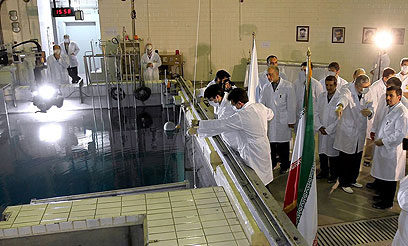
The study by the Washington-based Institute for Science and International Security (ISIS) will likely cast further doubt on Tehran’s denials that it is seeking atomic bombs as the UN nuclear agency prepares to publish a new report on Iran in the coming days.
Related stories:
- Khamenei: Iran not seeking nuclear weapons
- IAEA: Nuclear talks with Iran failed
- 'Iran will act against enemies if endangered'
Iran’s Physics Research Center was established in 1989 "as part of an effort to create an undeclared nuclear program," according to ISIS’s president David Albright, a nuclear expert and former inspector for the UN International Atomic Energy Agency (IAEA), as well as Andrea Stricker and Paul Brannan.
"Although Iran has admitted that the PHRC was related to the military and had a nuclear purpose in the area of defense preparedness and radiation detection, its actual nuclear role appears much more extensive," the ISIS report said.
The Iranian research center was established a year after the end of the 1980-1988 Iran-Iraq war, in which Saddam Hussein’s troops used chemical weapons against Iranian soldiers.
According to the UN nuclear watchdog’s November 2011 report on Iran, the Physics Research Center was established at Lavizan, a complex near a military installation in Tehran.

Ahmadinejad visiting the center (Photo: EPA)
Lavizan was completely razed in late 2003 and early 2004. Western diplomats and intelligence sources said at the time that they suspected Tehran was conducting undeclared nuclear activities at Lavizan and was determined to cover them up.
ISIS said it has acquired more than 1,600 telexes relating to the nuclear procurement activities of the Physics Research Center and Sharif University, another Iranian institution involved in Tehran’s nuclear research, in the 1990s.
"Iran has failed to declare all of PHRC’s activities to the (IAEA)," the Albright group’s report says. "Iran has stated to the IAEA that the PHRC procurements were not related to a nuclear program. The information assembled in this ISIS report, however, contradicts this claim."
Extensive cover-up?
If the allegations are confirmed, they could show that Iran’s suspected nuclear cover-up is far more extensive than was previously known. This may annoy Iranian allies such as Russia and China, which have slowed the push for new sanctions on Iran while pressing Tehran to cooperate with the IAEA.
While the exact nature and full scope of the Physics Research Center’s nuclear-related activities "remains difficult to fully understand,” Albright’s report said it is time for the Iranians to come clean about the center’s past work.
"Iran should clarify PHRC’s exact purpose and accomplishments and its relationship to the IAEA’s broader question of the military dimensions of Iran’s nuclear effort," the report said.
UN nuclear officials have repeatedly complained that Iran has not fully cooperated with their attempts to shed light on the full extent of Iran's nuclear program, which it kept hidden from agency inspectors for nearly two decades until 2003.
The IAEA sent several senior officials to Iran recently to persuade Tehran to grant them greater access to the nuclear facilities but failed to win any pledges to boost cooperation. The setback could raise the risk of confrontation between Iran and the West.
The IAEA has been looking into the Physics Research Center, which acted as an umbrella organization under Iran’s defense ministry and coordinated various nuclear activities.
According to the IAEA, by the early 2000s, the Physics Research Center’s activities had been folded into the so-called AMAD Plan, which was responsible for what the IAEA refers to as “alleged studies” into research and development relevant to building nuclear weapons.
- Receive Ynetnews updates
directly to your desktop















